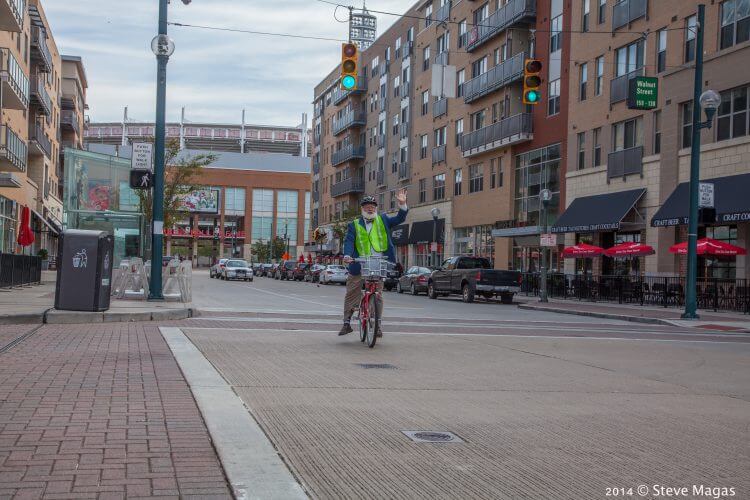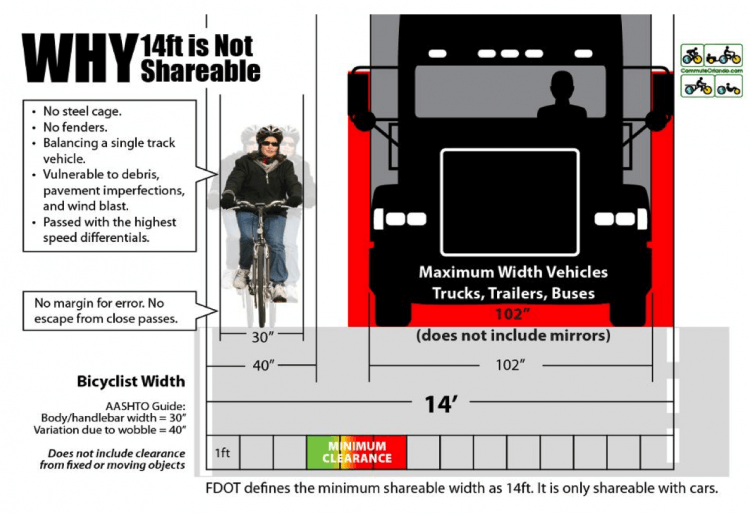Very nice article by CO bike lawyer Megan Hottman analyzing Colorado’s version of O.R.C. Sec. 4511.55 in Ohio – the “Where in the heck are cyclists supposed to ride” statute…
http://www.roadbikereview.com/…/how-far-to-the-right-should…
In Ohio, the law is far less wordy.
ORC Section 4511.55(A) imposes the general rule:
4511.55(A) Every person operating a bicycle upon a roadway shall ride as near to the right side of the roadway as practicable obeying all traffic rules applicable to vehicles and exercising due care when passing a standing vehicle or one proceeding in the same direction.
4511.55(B) is not a “where to ride” law, exactly, but it IS important. 4511.55(B) allows cyclists [and motorcyclists] to ride ‘no more than” two abreast. Before we got the C-Section passed in 2006 I argued for years that the Two Abreast section, when read in conjunction with the A-section gave two cyclists the right to an entire lane…and if two got the entire then 1 should get, at a minimum, half the lane…
But then came 4511.55(C)
The Ohio Bicycle Federation Board went round and round about this. In 2006 we put together the Better Bicycling Bill, a very large bill that impacted many Ohio Revised Code sections in very important and helpful [pro-cycling] ways. 4511.55(C) was certainly one fo the most important pieces.
Prior to 4511.55C there was ZERO definitional teeth for the word “practicable.” What did “as near to the right side of the roadway as practicable” even mean?? I had argued for years that “practicable” HAD to have elements of “safe” and “reasonable” built into whatever the definition was because, I reasoned, the legislature would never mandate that a vehicle operator operate the vehicle in an unsafe or unreasonable manner. We incorporated these elements into 4511.55C along with some HUGE exceptions to the “far right as practicable” test.
Here’s the Ohio language:
4511.55(C) “This section does not require a person operating a bicycle to ride at the edge of the roadway when it is unreasonable or unsafe to do so. Conditions that may require riding away from the edge of the roadway include when necessary to avoid fixed or moving objects, parked or moving vehicles, surface hazards, or if it otherwise is unsafe or impracticable to do so, including if the lane is too narrow for the bicycle and an overtaking vehicle to travel safely side by side within the lane.”
First- note that this is an EXCEPTION to the AFRAP rule. If it is “unsafe” or “unreasonable” to right to the right then the (A) section does not apply, the rider does NOT have ride to the right, and the rider can use the entire lane!
We then added some examples of when it could be necessary to NOT follow the AFRAP rule – to avoid fixed objects, moving objects, parked or moving vehicles, surface hazards…. a general category of “otherwise unsafe or unreasonable” scenarios INCLUDING… and this was/is the kicker…
IF THE LANE IS TOO NARROW FOR THE BICYCLE & AN OVERTAKING VEHICLE TO TRAVEL SAFELY SIDE BY SIDE WITHIN THE LANE…
This means that just about EVERY lane in every city and town and village in Ohio is ripe for avoiding the AFRAP rule. Just about every lane is “too narrow” to fit a bicycle operator + 3′ for passing + a big truck or bus… The language is there to be argued in any type of case in which the lane is narrower than, say 15′ wide…
Florida cycling advocate Keri Caffrey created this visual to show why a 14′ lane is “too narrow” to “share.”
Now… I made this argument in an AFRAP case a year or so ago…and lost… in Fairborn, Ohio. The police followed my client for a couple miles, shooting video. To ME, the video looked like a “How To Ride in Traffic” instructional video. However, the officer didn’t like the lane position taken by the client. We made the arguments but the judge agreed. Many problems in that case- the police never said “HERE” is where the infraction occurred – rather they just followed him for a few miles. There WERE spots on that path there were 15′ wide or so but most were not.
On cross examination I asked the officer to point to the magic line on the roadway that marked the area in which a cyclist was supposed to ride. Of course, he couldn’t do that – I argued that the law was too vague to be obeyed. How is a cyclist supposed to know where to ride without getting ticketed if the police officer writing the ticket cannot explain, or show the court, where he could have ridden to NOT get a ticket?
Perhaps we could have made an appellate argument along these lines, but I did not think this was the case in which to do so for a variety of reasons – the most important of which was that I did not want to set a lousy precedent.
However, in this case, it appeared that the prosecutor & police really had my client in their sights… he had been “warned” once before. He requested the cruiser cam from the warning. He was ticketed on the day he rode to the police station to pick up the video- on his way home from the police station…
So was he selected by the officer for ticketing? Yes, he arguably was although the officer denied it on the stand. Does that matter? No, the argument goes… if you’re breaking the law you’re breaking the law. Here, despite our arguments to the contrary the court found the cyclist was breaking the law.
I’d make the same arguments in ANY AFRAP case. The law is vague – too vague to be enforceable. The law mandates that the court look at the situation from the CYCLIST’s perspective, not the viewpoint of those behind the cyclist. The law allows non-AFRAP riding on just about every road in Ohio. The C-Section’s exemptions prevail… if the court is unwilling to listen there’s little we can do… except keep riding… keep taking the lane in a safe and reasonable manner…and keep on fighting to protect our right to the road…
Let’s Be Careful Out There…
© 2025.

